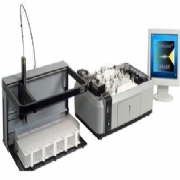 Add My Company
Add My Company
Sign In

Skalar has automated the detection of trace concentrations of formaldehyde in water and the total concentration of formaldehyde in adhesives on the San++ in cooperation with Dynea. Dynea is a global leader in providing high performance adhesion and surfacing solutions for the wood-working industry and other industrial applications. Automating these analytical procedures with the San++ provides Dynea excellent, reliable and reproducible results and saves on costs and labor time.
In 2004 the International Agency for Research on Cancer (IARC) of WHO, decided to recommend the reclassification of formaldehyde as “carcinogenic for humans (group I)” on the basis of available scientific data. Since then a lot of countries have tightened their regulations on formaldehyde emission resulting in the use of a wider range of emission test procedures and an increase of the amount of emission samples.
Most of these emission tests are labor-intensive, tedious and time-consuming manual wet chemistry analyses. Therefore Skalar and Dynea started a cooperation to fully automate the acetylacetone analytical procedure (for detection of formaldehyde in water and adhesives) using continuous flow technology
Trace concentration of formaldehyde in water
All steps from Dynea's classical manual method are fully automated including automatic preparation of calibration standards. Vials with the formaldehyde samples are placed on the sampler. To avoid any contamination from the air, septum sealed vials are used. Samples are automatically picked up by the autosampler. After colorimetric reaction and photometric detection, the sample results are automatically calculated.
Comparison of performance data; manual versus automated method
Dynea's classical manual method Skalar's SAN++ automated method
LOQ 30 ppb < 10 ppb
Range 30 ppb -1 ppm 10 ppb - 1 ppm
Time of analysis First sample; approx. 2 hr. and 3 hrs. to process 10-20 samples
First sample; 10 min. and subsequent samples 2 min.
Total concentration of formaldehyde in adhesives
The manual procedure for analyzing the total concentration of formaldehyde involves many sample pretreatment steps including hydrolysis, distillation and titration. All these steps can be automated using the San++ analyzer, where the titration step is replaced by the colorimetric acetyl acetone method as for free formaldehyde. This reduces the amount of manual analyzing steps to a large extend.
Results are available in 20 minutes compared to the traditionally wet chemistry procedure, which takes more than 2 hours. Sample throughput of automated method is 15-20 samples per hour, while in the manual method each sample requires more than 2 hours analyzing time.
Accuracy
•Deviation from ‘reference values'
LT ± 0,5 % formaldehyde
Precision
•Repeatability RSD < 0,5 %
•Reproducibility RSD < 1,0 %
The automation of both formaldehyde applications with the Skalar San ++ analyzer gives excellent results and saves time & costs. In addition the continuous flow technology provides better reproducibility as all samples and standards are treated exactly the same way for exactly the same time compared to the manual method where the timing can always slightly vary from sample to sample. Calculations are made automatically and thus minimizing human errors. The results can be directly exported to a LIMS or downloaded to Excel and customized print reports can be generated.
For more information about the above described methods or other applications, please contact Skalar.
For more information on Formaldehyde analysis with the SAN++ analyzer talk to Skalar (UK) Ltd
Enquire Now
List your company on FindTheNeedle.
